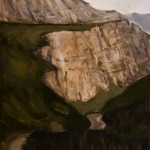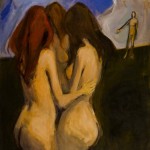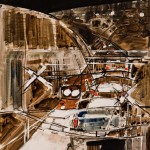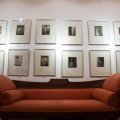March 30th, 2022
Hey. Long time no see!
Good news. The Hidden Lane Gallery is open again.
We are now located in the Hidden Lane itself (straight ahead then on left when you get through the pend).
You’ll spot our wonderful windows!
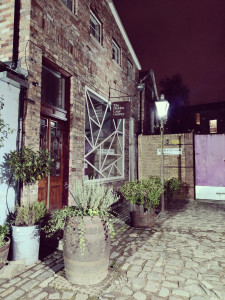
The Gallery will be a home for the wonderful photographic work of Margaret Watkins – classics upstairs and rotating themed exhibitions of her photography in our downstairs space.
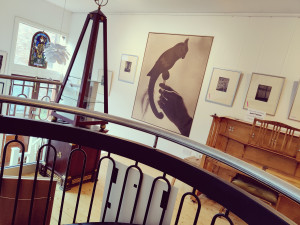
Swing by and say ‘hello’.
On June 25th 2021Glasgow’s Street Level Photoworks hosted a great ‘Close Up’ session with Joe Mulholland and Di Chroma’s Anne Morin, the curator of a recent, beautiful tour of our much loved photographs round Europe.
If you missed it you can catch it here.

January 11th, 2020
An exhibition celebrating art, and in particular African Art, as a contributor to world unity, economy, culture and humanity. Humankind is known to have its earliest origin in Africa. Africans have since excelled in various art forms. African art is known to have inspired international artists such as Modigliani, Picasso, Giacometti, Matisse, the Paris movement and many more; to this day African art remains intriguing, exotic and powerful.
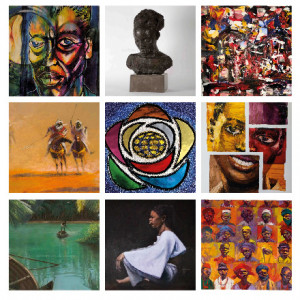
Africa is blessed to have art as a vital force that positively enhances its image and adds to her GDP. African artists were well respected in their communities and most had other occupations but evoke happiness and other emotions to their communities through their art. Art uses were varied, from celebration of birth, life, death, religion, decoration, royal recording, documentation of important occasions etc.
We are delighted to collaborate with Johfrim Art & Design to showcase modern-day African artists whose ancestors produced masterpieces on show in museums and important collections around the world.
Like their forefathers they are mostly influenced by nature, communities, spirituality, and life around them. The world is more global, but our African artists are telling their stories through their art. Their contribution is countering some of the accepted negative impressions of Africa.
EXPRESSIONS will run until 31st March 2020
October 4th, 2019
We rounded off 2019 with a mixed exhibition of art from Haiti and from Russian artist Bazhena Kutergina.
Downstairs we had Alasdair Gray’s giclees on show again. Another popular opportunity to access Alasdair’s much loved art in its more accessible limited run signed print form.
In the main gallery we had beaded works from Haiti by Jean Baptiste Jean Joseph, and were reshowing some of Haitian Frankétienne’s wonderful paintings and eighteen of Russian artist Bazhena Kutergina’s original drawings.
Jean Baptiste Jean Joseph was born in 1967 in La Vallé Bainet and was raised in Croix-des-Bouquets, a community known for its metal artisans in Port-au-Prince, Haiti. At a young age Jean Baptiste developed a passion folk art and textiles. Following his passion for beadwork, he worked in a small factory where he honed his skills by sewing pearls and beads onto wedding dresses. Then in 1991, thanks to a small loan from a friend, Jean Baptiste opened Isidor Gallery in Croix-des-Bouquets
Fast forward two decades, and Jean Baptiste’s beadwork is known world-wide. Besides his famous vodou flags, Jean Baptiste and his fellow artisans make purses, bags, vodou dolls, and various other handicrafts.
Original drawings by Russian artist Bazhena Kutergina
Bazhena Kutergina was born in St Petersburg, Russia. She graduated from St Petersburg State Academy of Art and Design (equivalent to a Bachelor’s Degree and Master’s Degree).
Bazhena worked as an artist at a blown glass factory in St Petersburg, Russia from 2001 to 2014 where she worked predominantly with blown glass created for exhibitions and Russian art galleries. In 2012-2013 she was invited to take part in TV and radio programs about art glass. Now she works as a glass and ceramics conservator at the State Hermitage Museum, St Petersburg, Russia.
Paintings by Frankétienne
Frankétienne started to paint in 1970, and has exhibited regularly throughout his career. In the early stages his work was influenced by American artists particularly Jackson Pollock, but by the early 1980s he had developed his own distinctive and authentic style, which combines figurative forms with abstract structures. Frank writes in French and Creole. His was the first novel written in Creole in the sometimes troubled Caribbean republic that broke away from France in 1803, defeating Napoleon’s armies a dozen years before Waterloo.
This was the second exhibition of Frank’s work, the previous one in 2014 was shared with his contemporary, Alasdair Gray.
May 25th, 2019
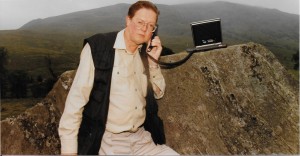
Paul Harris was an award-winning correspondent covering some of the bloodiest conflicts in words and photographs. This exhibition chronicles his time in the former Yugolslavia when local ethnic tensions broke out developing into a most brutal civil war.
His pictures and words tell the true stories of the horrors which were being played down by most countries throughout the world. Bombed houses and mass graves – but the real horror is seeing life going on as normal within shouting distance of crimes against humanity.
This show was put together by his wife, Sulee to bring truths that most have forgotten back into the public domain.
The exhibition ran until the end of September 2019.
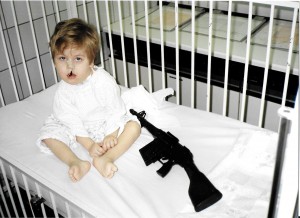
March 22nd, 2019
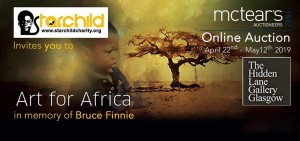
Starchild is a Glasgow based charity that believes the development of young people can be significantly enhanced through the inspiration provided by their participation in the arts.
We welcomed them to the Gallery in April/May 2019 with around 100 wonderful paintings including works by Peter Howson, Ross Muir, Alexander Millar, Frank McFadden, Laetitia Guilbaud, Moe Rocksmoore and Iain Faulkner.
The charity has deep links with Uganda and has built a School for Creative Arts in Uganda. This school and vocational centre allows vulnerable young people, who would otherwise never have the opportunity to develop creative talents, a chance to build up their skill base, enhance their prospects and provide many hours of enjoyable tutoring and performances.
In partnership with the Gallery and McTears auctioneers the online auction was live from April 22nd through until May 12th and raised an incredible £17,000.
This year Starchild held the auction in memory of a dear friend Bruce Finnie. Bruce owned By Distinction Art, Byres Road and supported Art for Africa from the beginning.
February 16th, 2019
Back in November French President Emmanuel Macron agreed to return, “without delay”, 26 African artworks claimed by African Republic, Benin.
It has been estimated that some 90% of African art is housed outside of the continent.
Owner of the Hidden Lane Gallery, Joe has made the decision to return his own collection (sourced mainly from the Glasgow auction rooms) to the museum in Bamako, Mali (and to the museum in Port au Prince, Haiti).
The art that has been selected by the Malian museum was on display from 16th February into March at the Gallery.
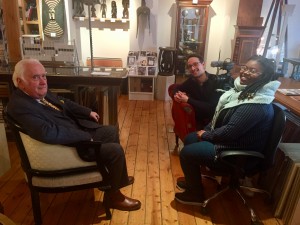

August 7th, 2018
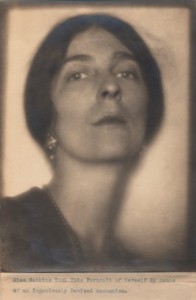
Classic Margaret Watkins
From Tuesday 14th August
This exhibition has been put together to show the wonderful range in both subject and treatment, of the work of Margaret Watkins. She lived for 40 years in Glasgow in the seventeen-room dark and dreary house from which her mother had married in 1881. Margaret was born in 1884 and after a business disaster for her father she moved ultimately to New York in her early 20s and took up photography around that time. She attended the renowned Clarence White School of Photography and after a few years was taken on to the staff. She taught many known photographers including Paul Outerbridge and Margaret Bourke White. Others were credited with bringing their cameras into their kitchens. She taught many of these people who were later credited with this innovation. In New York she was at the top of her profession, editing the prestigious annual publication for Pictorial Photographers of America and working with Gertrude Käsebier, Edward Steichen and Alfred Stieglitz. In 1928, after a professional and personal upset with Clarence White’ widow, she came to Glasgow, intending to stay and ‘do Europe’ for a year or two. Forty-one years later she died in Glasgow with her bags still packed to return to New York.
Prior to her death in 1969 she gave a present to her neighbour, gallery proprietor Joe Mulholland, a large box wrapped in brown paper, tied and sealed with ceiling wax, but with one condition: he was not to open it until after her death. In her years as a recluse in Glasgow, she never once mentioned photography, the field in which she had excelled. For almost 50 years Joe Mulholland has worked to establish her position in the history of photography and as a great artist. A major exhibition in the National Gallery of Canada in 2012 gave her the accolade that had eluded her in her lifetime. She is now represented in many major international public collections and her work has appeared in dozens of books.
As well as the major works on show made by her in New York, there is a selection from her work in Glasgow, London and especially Paris and Russia.
The Hidden Lane Gallery, at 1081 Argyle Street, Glasgow G3 8LZ, is open Tuesday to Saturday from 11am-5pm
February 8th, 2018
‘African Artefacts: The Final Selection’ showcased a fascinating range of sculpture, masks and everyday objects from sub-Saharan Africa.
A wonderful opportunity to explore the arts of Africa, in all their breath-taking diversity.
The exhibition ran from February until Early August 2018.
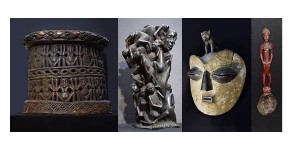
October 30th, 2017
Launching on November 9th (Preview on 8th) was a third chance to see the wonderful work of artist Hilda Goldwag.
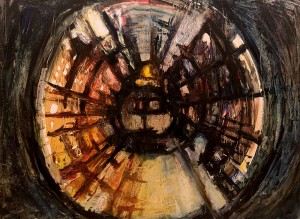
A comprehensive range of works in paint and pencil by the Vienna-born artist who spent seventy of her ninety-four years in Glasgow, escaping from the Holocaust which killed all other members of her family. Her dramatic use of colour, and the subtlety of her pencil and pen drawings have continued to enhance her growing reputation.
This exhibition ran into the early part of January 2018.
May 21st, 2017
The Hidden Lane Gallery were pleased to offer throughout Summer 2017 a collection of some of Alasdair Gray’s striking images in Giclée print form. The principal motivation came from a request by Alasdair to make his works more affordable, to share them with more people.
The show consisted of twenty-one images (two differing colour versions of the delightful ‘Little Indian’ portrait of Alasdair’s son Andrew as a young boy) and ranged from the superb ‘The Card Players’, created by the artist when he was still at school – aged sixteen in fact, to the almost psychedelic colour abstracts which he has been working on in the past few years.
Prices in the catalogue are for unframed prints available in the gallery. Many of the prints are still available at the Gallery despite the show being closed.
OPENING HOURS
Tuesday to Saturday 11a.m to 5 p.m.
Tel: 07760 669011
Email: gallery@hiddenlanegallery.com
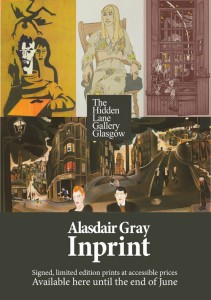
October 15th, 2014
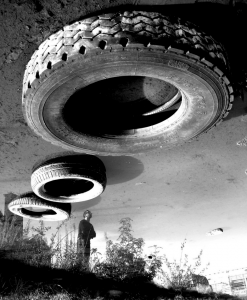 Traditional views of Glasgow in the eighteenth and nineteenth centuries balance contrastingly with the Shadows series of photographic images by Glasgow-born digital artist and filmmaker Robin Johnston, whose work has been selected for several awards. Key influences for Robin are Bill Brandt and Brassay.
Traditional views of Glasgow in the eighteenth and nineteenth centuries balance contrastingly with the Shadows series of photographic images by Glasgow-born digital artist and filmmaker Robin Johnston, whose work has been selected for several awards. Key influences for Robin are Bill Brandt and Brassay.
The older Glasgow paintings and prints underline how much the city has changed over the years, and includes many rare and original watercolours from the late eighteen hundreds by David Small, the illustrator of many now-rare books on Glasgow.
Exhibition runs from October 18th to late November 2014.
Open Tuesday to Saturday from 11 a.m. to 5 p.m.
September 10th, 2014
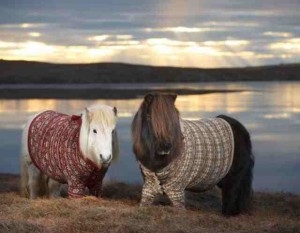
Seeing ourselves as the press sees us is the current exhibition at the Hidden Lane Gallery.
Scottish identity is the subject of this exhibition of photos shown in conjunction with the Scottish Press Photographers Association, highlighting the work of editorial photographers. The chosen pictures range from politics to sport and features, documentary, landscape, the street, portraiture, industry, to the arts and entertainment. The brief to photographers was to keep it as open as possible they could interpret the brief as tartan or as tenuous as they wished. And images could be new or from their archive.
In total the exhibition represents 35 photographers working in the editorial photography within Scotland. It is a good mix of staff and freelance photographers. We would like to thank the participation from the staff photographers of The Herald and Evening Times, The Sunday Mail and Daily Record and The Scottish Sun.
Thanks also to our selection panel which included Gallery Owner Joe Mullholland, Photographer and Lecturer Brian Swinburne and former Sunday Times (Scotland) Picture Editor, now currently at The Sunday Post, Jeremy Bayston.
June 5th, 2014
The Hidden Lane Gallery is delighted to be showing the most complete collection of pictures by photographer Margaret Watkins to date, including previously unseen work. Margaret Watkins was of Scottish and Canadian descent, and went to America in the 1910′s, where her gift for composition and bold choice of subject made her a considerable success. She came to Scotland and used Glasgow as a base to travel and take pictures in Moscow, Paris and beyond. This exhibition of over 70 pictures will run through the West End Festival and beyond. Admission free.
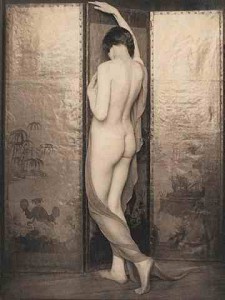
February 21st, 2014
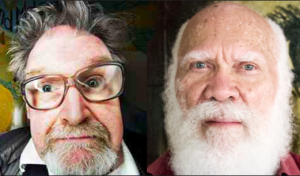
Leading Scottish writer Alasdair Gray is also an established artist, who this year celebrates his 80th birthday. Poet, painter, graphic artist and short story writer, he will have a major retrospective exhibition at Kelvingrove later this year.
He has recently been branching off in a new direction with his paintings, experimenting with abstract design and colour. A half dozen of these paintings form a third of the Hidden Lane Gallery’s show.
He will be joined on the gallery walls by Haiti’s leading writer, Frankétienne, the 78 year old poet, song writer, novelist, graphic artist and painter whose name has been mooted as a possible Nobel literature laureate. Frank will show a dozen of his most recent works and launch a CD of his songs and poems set to music by Haiti-based Glaswegian Mark Mulholland. Frank recites and sings while Mark plays on guitar. Frank writes in Creole and French. His was the first novel written in Creole in the troubled Caribbean republic that broke from France in 1803.
The parallels between the two artist/writers are extensive and fascinating.
During the exhitibition we will have for sale limited first edition hardback copies of Gray’s ‘Mavis Belfrage’, ‘The Fall of the Kelvin Walker’ and ‘A History Maker’ at their original published prices, and limited edition screenprints by Glasgow Print Studio. Also for sale is the most recent highly acclaimed Frankétienne/Mark Mulholland collaboration CD ‘Chaophonies’.
Saturday 22nd March – Saturday 17th May 2014
February 1st, 2014
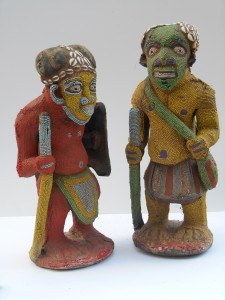
8 February – 15 March 2014
This month the Hidden Lane Gallery hosts a selection of African artefacts, brought to Europe by colonists, evangelists and soldiers, and collected over several decades from auctions and on European trips. Available for public viewing for the first time, the collection consists of masks, statues and carvings from the past 200 years, and some contemporary pieces.
We will be holding another exhibition of African Artefacts in October this year.
October 25th, 2013

Continuing its series of exhibitions of the work of Margaret Watkins, the celebrated Canadian-born photographer who lived in obscurity in Glasgow for the last 40 years of her life, the gallery shows, for the first time, her innovative approach to photography for advertising. Much of it appeared in The New Yorker, Harpers Bazaar and the daily papers in New York, commissioned by clients such as Macy’s famed stores, leading American and French cosmetics companies and many others. She applied her artistic eye to each subject, determined to turn the advertising into something more artistic and attractive, just as in her approach to her other, better known, pictorial work.
The show opens on November 9th and will be running until February 2014.
September 17th, 2013
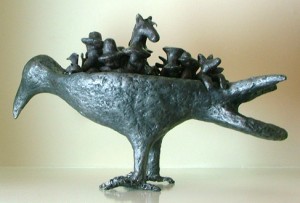
An artist of extraordinary diversity, Sue Macpherson has exhibited extensively in the north and northeast of Scotland. Artist-in-residence for the Whale and Dolphin Conservancy Council, Sue’s work often reflects her environmental and social concerns. This is her first exhibition in the west of Scotland.
The show opened on September 28th and will be running until November 2nd.
July 24th, 2013
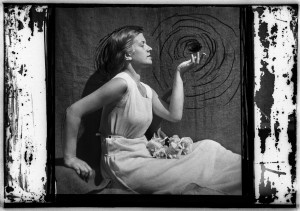
10 August – 20th Sept
Domicele Tarabildiene – A Challenge to Time
Domicele Tarabildiene (1912–1985) was a well known interwar artist whose spectrum of creative means and expression was wide – engraving, book illustration and applied graphics, painting, and sculpture. Her poetic and surreal photography, however, has only recently attracted public attention in Europe. This exhibition is the first time this work has been seen in Scotland – indeed the UK – and presents 34 signficant photographs from the early 30s, most using the photomontage technique. “What is fascinating is not just the artist’s courage in exploring experimental forms of expression, but also her decision to be her own model in the photographs. Her artistic exploration crossed the line of experimentation, and testifies to her interest in the avant-garde constructivist ideas of the time, as well as her exceptional ability to express herself creatively in various art forms. Tarabildiene is a symbol of human emancipation; although she was born in the countryside, she matured as an artist in the town, and used it as a source of creative inspiration.” Ieva Mazuraite-Novickiene, National Gallery of Art of Lithuania.

This exhibition is part of the Lithuanian Season of Photography in the West of Scotland and is presented at Hidden Lane Gallery in partnership with Street Level Photoworks and Kaunas Photography Gallery.
Running concurrently at Street Level Photoworks (August 10th to 6th October) is ‘Borderlands II’. Seewww.streetlevelphotoworks.org for details of all exhibitions.
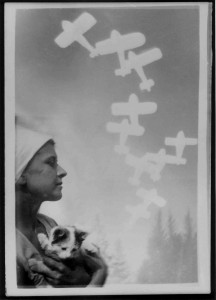
July 10th, 2013
The Gallery will be closed this Saturday for the funeral of Gallery co-owner Claire Mulholland. The funeral mass will be held at 11am on Saturday 13th of July at St. Peter’s, Partick. All family and friends are warmly invited to attend.
June 3rd, 2013
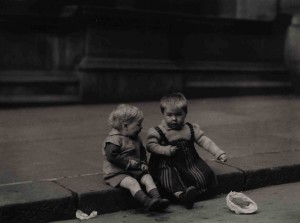
Paintings, photographs, prints, etchings and models of Glasgow and its river, including works by Margaret Watkins, Oscar Marzaroli, Hilda Goldwag, David Peat, Robert Burns, Craig and Thomas Annan and many others.
On until August 3rd, 2013
January 31st, 2013
Margaret Watkins and the Clarence White School: Palladium and Platinum Prints 1919 – 1925
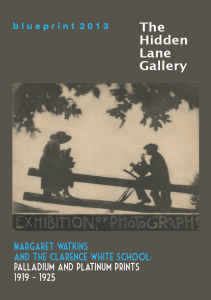
The Hidden Lane Gallery shows palladium and platinum prints by Margaret Watkins and many of her students at the Clarence White School of Photography in the period 1919-1925.
The School opened in New York in 1914. Watkins attended its Summer Schools and was apprenticed to Alice Boughton, a portrait photographer in Boston, herself taught by the renowned photographer Gertrude Kasebier. Watkins became a full time student around 1917, and within a few years joined the staff. The curriculum for the school included commercial and hand-coated platinum, silver, printing out and gaslight, single and multiple carbon , single and cowhide gum, oil, bromoil and photogravure.
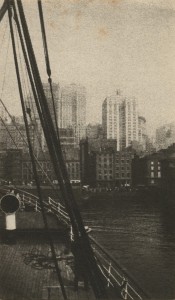
During the First World War the price of platinum rocketed, as it was needed for explosives and ammunition – which multiplied the cost of making platinum prints. This led to the development (by William Willis in 1915) of the palladium process, using a metal closely related to platinum, and creating Palladiotype paper. White, Watkins and others at the school adopted this process.
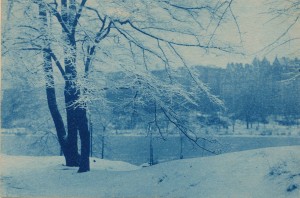
After her arrival in Glasgow in 1928, Watkins continued to use palladium – but more importantly for the current exhibition, she bequeathed her own photographs and a unique collection of many by her students to her neighbour Joe Mulholland. These show works by known and unknown names; class exercises demonstrating up to ten different treatments of a single image, her hot processes, blue prints, carbon examples and some processes which even the experts are now unclear how the effects were achieved – or what the process was.
Margaret Watkins and the Clarence White School: Palladium and Platinum Prints 1919 – 1925 is part of the Blueprint Photography Festival, along with venues including Trongate 103, Street Level, Glasgow Print Studio, the University of Glasgow, Riverside Museum, the Mitchell Library and RGI Kelly Gallery. The exhibition runs from February 8th until March 12th, 2013.
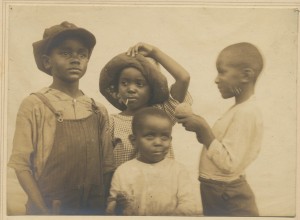
January 22nd, 2013
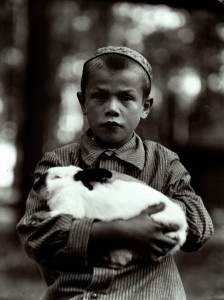
Arrested by officers of OGPU — the KGB’s predecessor — Margaret Watkins claimed her photographs of their HQ in Moscow were purely to record post-revolutionary Russia. The Glasgow-based photographer was in a group organised by a fellow member of the Royal Photographic Society, through Intourist, the State agency charged with bringing visitors, and foreign currency, to the country.
It was in August 1933 that they set off from a wharf on the Thames near Tower Bridge, London, in the State-owned Cooperatzia. First call was Leningrad, where they were given the ground rules; photograph no bridges, military installations, soldiers’ manoeuvres, public or military buildings — especially not the Kremlin. These could be of use to foreign enemies planning a bombing campaign on the understandably paranoid post-Revolution State. So only the odd soldier in the streets or on stage at a state-run youth rally. Lots of snaps of processions, picturesque windows, interesting characters and blocks of workers’ flats. These latter would show how the Soviet Socialist Republic looked after the proletariat.
One building looked as interesting as the next to Canadian-born Margaret Watkins, who had come to Glasgow in 1928 to visit her maiden aunts in Hyndland, in the house from where her mother had married in 1877. Worker flats were snapped with titles later appended by her, like “Reconstruction” or “Progress”. However, one block proved to be a problem. No sooner had she set up her Graflex camera and clicked a few shots than she was descended on by the security police, and rushed to the secret police headquarters.
Hours of interrogation by junior officials followed and things looked gloomy for her. She explained that she thought the impressive building looked like good workers’ acccommodation. Her camera and films were taken away to be examined. A senior official became involved. She explained again. She was a photographer, following in the footsteps of one of her illustrious pupils, Margaret Bourke-White, who had visited Russia a couple of years before, and produced a six-part series (adulatory, of course) on Russia. The series had been published the previous year in the New York Times magazine, to the great joy of the Russian State propagandists.
Sense prevailed and she was released, with her beloved Graflex — but sans film. All film taken on the trip had to be surrendered to the authorities, who had it developed, inspected and (if found to contain no prohibited images) returned in a sealed envelope. This envelope had to be produced at the port of departure, opened by the Secret Police agent there, and checked against the inventory of approved images that accompanied it.
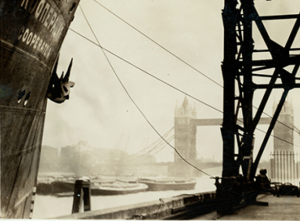
Margaret Watkins got out of the country with over 600 negatives. She made silver gelatin prints from a small number of these (some to exhibition standard) when she returned to her aunts’ home in Westbourne Gardes in Glasgow’s West End.
Eighteen of her original prints are now on show at the Hidden Lane Gallery in Argyle Street, Finnieston in Glasgow, together with another 80 from the “approved” negatives. These are also silver gelatin prints, made by Glasgow master printer and photographer Robert Burns. Most of these are now printed for the first time.
The Hidden Lane Gallery, at 1081 Argyle Street, Glasgow G3 8LZ, is open Tuesday to Saturday from 11am-5pm (www.hiddenlanegallery.com). The Margaret Watkins “Leningrad and Moscow 1933″ exhibition is on until 6th February 2013.
June 14th, 2012
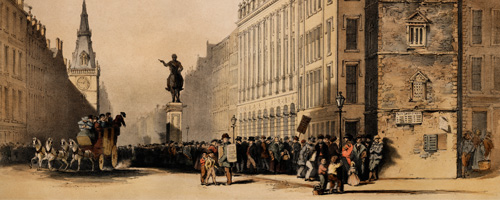
On until 21 August, 2012
An exhibition gathering together a hundred depictions of Glasgow through the ages by some of the many artists – citizens and visitors alike – who have recorded the changing faces of the city during the past four centuries. Quality prints of most of these will be available to order through the Gallery, or on the website.
Paintings, prints, etchings, photographs, lithographs, drawings (and even needlework and an ancient piece of stained glass of Saint Mungo) showing the changing city over the centuries.
Photographs by Thomas Annan from the 1870’s show the now romanticised squalor of what is today the Merchant City, enlarged by the Annan Gallery in 1926 from the original plates.
Coloured lithographs of the Clyde and the Cathedral from the early and mid 1800’s, and a glimpse of paintings from the Foulis Academy exhibited in the Old University of Glasgow in the High Street in the 1760’s.
A window on the city in the 1930’s as seen through the lens of Margaret Watkins, whose work goes on display in a major exhibition in the National Gallery of Canada in October and a fascinating panorama, drawn from a balloon suspended above the Gorbals and published in the Illustrated London News in 1864 – with detail clearly identifiable around much of the city including Wellington, without his bollard, in place outside the now Gallery of Modern Art.
And lots more.
Until 21st August 2012.
Open Tuesday to Saturday from 11 a.m. to 5 p.m.
March 30th, 2012

Hilda Goldwag was born in Vienna in 1912. As an artistically gifted child she attended Art School in her native city and graduated in 1938 with distinction. With the growth of Nazism life became increasingly fraught for anyone of Jewish origin. She got a permit to “escape” to Scotland in 1939, and worked as a domestic servant in a manse in West Linton. Her family were due to follow in September 1939 – the day war broke out. All died in Dachau, including her four year old nephew.
During the war years she worked (as an enemy alien) in factory jobs.
Living in Hill Street, Garnethill, near the Glasgow Art School she had various art related jobs and soon took up painting again. She became a familiar sight with her easel and paints and brushes in the area, and her paintings began to appear in exhibitions. She moved to a low rise flat in Yoker/Knightswood after the Great Storm of 1968 took the roof off her city centre flat.
Painting had become a full-time occupation with solo shows in Greenock and Gourock in the 1970’s , in the Royal Glasgow Institute’s Kelly Gallery in Glasgow, and the Lillie Gallery in Milngavie in the eighties. A major exhibition of her work appeared at the University of Strathclyde’s Collins Gallery in 2005.
She painted until a year or two before her death in January 2008, trailing around the area – the parks and canal banks – with her gear stacked on a supermarket trolley. She ventured out to Kirkintilloch and other spots in bussing distance from Glasgow – returning with her large canvases or boards, the paint still wet, spread on the bus luggage racks.
When she died her little flat was stacked with paintings. Most of these reached auctions – for very successful sales. An exhibition of many of these was mounted at the Hidden Lane Gallery in Argyle Street in Finnieston, in 2010 and achieved considerable interest.
During the show a dustbin man came in to the Gallery and spoke to Gallery director Joe Mulholland. “Are you interested in drawings by Hilda Goldwag?” he enquired.
Mulholland was very interested. The dustbin man told him that he worked “with the Clennie” in the Yoker/Knightswood area and had known the old lady by sight, as she trundled around with her paints and paintings. When emptying the bins at the block of flats where she lived, he saw bags of what looked like interesting stuff among the rubbish. He opened them and found half a dozen sketch books and individual drawings.
“I thought it was a shame to have these destroyed and lost, so I took them home.l”
When he saw Hilda Goldwag’s name on the Hidden Lane Gallery window, it rang a bell. So he brought the sketches and drawings in. Many were simply studies for later paintings. Many were fine drawings able to stand by themselves.
The Gallery gave him a very substantial “reward” for his foresight and appreciation – but he wanted no personal recognition for saving the works. (and some of the painting materials: brushes, palette knives and scrapers) “I would get my books if my bosses found out I had kept these back from the trash”, he said.
The exhibition at the Hidden Lane Gallery shows dozens of these drawings, and the notebooks alongside a representative selection of Hilda Goldwag’s “people” paintings, since most of the drawings and sketches are of people.
The exhibition starts on Saturday 31st March, and is open Tuesdays to Saturdays from 11 am to 5 pm.
December 12th, 2011
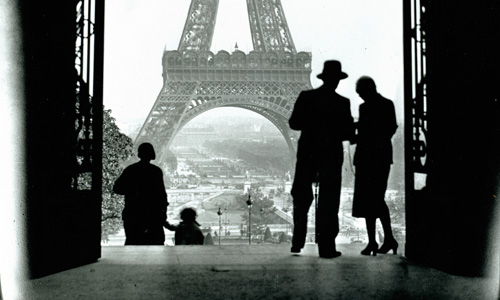
The third exhibition at the Hidden Lane Gallery of the work of Margaret Watkins, almost half of whose life was spent unknown in Glasgow, covers previously unseen images from Paris, where she spent two productive months in the autumn of 1931.
When she died, in the gloomy seventeen room house in Glasgow’s West End in 1969, she left behind hundreds of “finished” images, many of which she had exhibited in major galleries in America, her home for over twenty years. These were secreted in a trunk she gave as a present to her new neighbour, Joe Mulholland on condition he did not open it till after her death. He did not know that she had been a photographer of note. He has spent the last forty years promoting her work, which is now recognised as being at the forefront of artistic and photographic achievement in the twentieth century.
She left behind thousands of negatives of her journeys from Glasgow to Germany, France and Russia. In November 2010, her Glasgow negatives were printed (by Robert Burns). Now we show a selection of those she made in Paris. Only a very small number were in other than negative form. Robert Burns has brought these to life, overcoming enormous difficulties due to the precarious state of the negatives, many of which had deteriorated with the years. All prints in the exhibition apart from those few originals by Margaret Watkins are selenium toned silver gelatin master prints by Robert Burns.
The exhibition has been extended until March 24th 2012.
October 5th, 2011
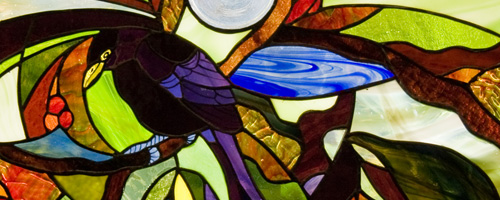
Born in Nenagh, Co. Tipperary, Ireland in 1941, Claire Mulholland studied at University College, Dublin, and the National College of Art, Dublin, before moving to Glasgow in 1964. Having spent much of her career painting in oils, she began working in glass in 1994. Her work has been exhibited in Scotland and Ireland, and is in private collections in the UK and Ireland, Germany, South Africa and Canada.
Subjects vary from abstract to figurative, spiritual to pictorial. The Rock Chapel windows bring the total of church windows to sixteen, including St Peter’s in Glasgow’s West End and St Brendan’s in Yoker, Glasgow.
“Back around 1994 I asked myself – what would I regret not having done? It was work with glass. I haven’t looked back. I love colour. I love the intensity of light through coloured glass – the way it changes, varies, and comes alive in different light and at different times of the day. I love the way it transforms a dull building, a dark corner or a dreary day. When I painted I tended to get bogged down in too much detail. The limitations of glass force me to approach things the other way round. What can I not leave out? It makes me focus on the essential, reduce to the simplest element. What line, shape, colour will express what I want to express?
I particularly enjoy abstract work, where possibilities of interpretation are open-ended and people can respond at many levels and in different ways. I had a dream for many years of doing a chapel of colours, with each window in a different colour of the spectrum, with a colour “psalm” to go with each. I had no idea it was waiting for me on top of a hill in North Wales!
The exhibition runs from Saturday 8th October until Friday 28th October.
August 27th, 2011
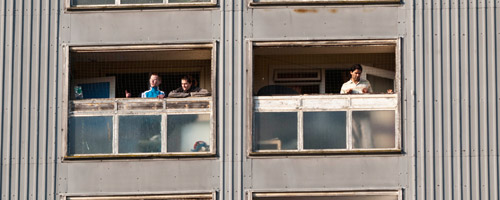
The idea for this exhibition came in conversations with freelance press photographer John Linton, and Suzanne Bunniss, who among many commitments , works with groups dedicated to assisting asylum seekers and other immigrants. The Red Road flats had become synonymous in central Scotland with the often grudging help given to those newcomers to Scotland in need of support. Meagre charity, often as cold as the clichéd adage, leaves not just gaps, but huge craters in the provision of help. The Red Road started with hope for badly housed Glaswegians. It has ended its days having become a bad name in all its functions
The pictures, by Scottish photographers document some of the sadnesses, and some of the joys which happened there.
The Red Road pictures appear upstairs. Downstairs is a selection of images submitted by Scottish Press Photographers, under the umbrella of the Association which they have formed to promote their work, which earns them an often precarious living. Photographers were staff men (very few women , then as now). Their work was often excellent, but often it was pedestrian. Today things are different; each photographer is only as good as his next picture. From the submissions received, standards have benefited from the competitive nature of the job today.
From the hundreds of entries received, the problem was not to find good images which would tell a story. Virtually every submission was worthy of inclusion.
The judges, Suzanne Bunniss, Alex Hewitt, deputy picture editor of the Scotsman, and Joe Mulholland had grave difficulty in narrowing the field to fit the wall space available. The same panel chose the images of the Red Road flats from a smaller, but equally accomplished field, again constrained by space.
All Gallery profits from sales of images will be donated to asylum seekers’ charities, with a further contribution from photographers whose work is sold.
From Saturday 3rd September until Friday 30th September.
March 19th, 2020
Due to the current uncertainties, we have made the decision to close the Gallery’s wonderful current exhibition of contemporary African art a few weeks early.
We will update you with what’s happening next in the Gallery when things become clearer over the coming weeks.
Stay well everyone and look after you and yours.
January 11th, 2018
There will be a very slight lull in proceedings here at the Hidden Lane Gallery as we prepare for our exciting, final African Art Exhibition.
Opening to the public from January 27, with a preview evening on Friday 26th, ‘African Artefacts: The Final Selection’ will showcase a fascinating range of sculpture, masks and everyday objects from sub-Saharan Africa. A wonderful opportunity to explore the arts of Africa, in all their breath-taking diversity. We hope you will make it along for a look over the next few months.
The Gallery will be closed from 11th January until the evening of the 26th (the office for the Hidden Lane and Hive will remain open).
August 9th, 2017
Launched on Saturday 12th of August, ‘Glasgow and the Clyde’ is an extensive exhibition and sale of early Glasgow paintings, prints and lithographs – images from 1694, through the famous Foulis Academy in the mid 1700s, and the dramatic and colourful Fairbairn scenes from 1849, as well as some photography by the celebrated Annan father and son, right up to Alasdair Gray’s evocative ‘Cowcaddens Streetscape in the Fifties’. The exhibition will close during the first week of November.

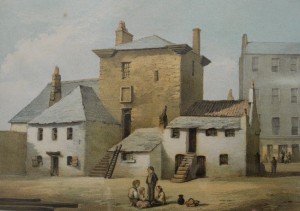
May 20th, 2017
This was the eighth show in our ‘Forgotten Women’ series and provided an opportunity to see the classic works made mainly in New York between 1917 and 1928 establishing Watkins as one of the top artists with a camera in the creative city.

June 6th, 2016
On until September 2016:
MASKS, MUSIC AND MAGIC

This is the second of our forays into exhibiting aspects of the art of Africa at The Hidden Lane Gallery.
‘A fascinating insight into the marvels of African art: masks, drums, and other artefacts, mostly from Nigeria, Ivory Coast, Gabon, Mali, Congo and the Kingdom of Cameroon, where royal workshops are distinguished by their innovative beadwork.
‘Often looked on in the West as ‘primitive’, this exhibition will prove the opposite. The design, the endlessly varied interpretations of human (and animal) heads – these imaginative works provided inspiration to the great European artists, stimulating the emergence of Cubism.’
May 16th, 2016

HILDA GOLDWAG PAINTINGS & DRAWINGS until 4th of June. About Hilda – see essay below.

IAN MACPHERSON’S EVERLASTING BOOK TOUR 20th of May at the Gallery. For a review of this show from last year’s Edinburgh Festival, go here , for Ian’s website, go here!
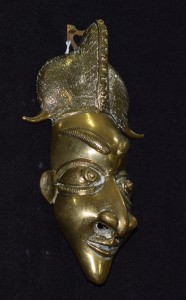
COMING NEXT AT THE HIDDEN LANE GALLERY: ARTEFACTS FROM AFRICA The second exhibition of masks, figures and carvings from Africa opens Saturday 11th of June 2016. The Gallery is open Tuesday to Saturday, 11am-5pm.
Hilda Goldwag (from the catalogue from previous Hidden lane Gallery exhibition, Drawings From The Dustbin)
Hilda Goldwag was born in Vienna in 1912. As an artistically gifted child she attended Art School in her native city and graduated in 1938 with distinction. With the growth of Nazism life became increasingly fraught for anyone of Jewish origin. She got a permit to “escape” to Scotland in 1939, and worked as a domestic servant in a manse in West Linton. Her family were due to follow in September 1939 – the day war broke out. All died in Dachau, including her four year old nephew.
During the war years she worked (as an enemy alien) in factory jobs.
Living in Hill Street, Garnethill, near the Glasgow Art School she had various art related jobs and soon took up painting again. She became a familiar sight with her easel and paints and brushes in the area, and her paintings began to appear in exhibitions. She moved to a low rise flat in Yoker/Knightswood after the Great Storm of 1968 took the roof off her city centre flat.
Painting had become a full-time occupation with solo shows in Greenock and Gourock in the 1970’s , in the Royal Glasgow Institute’s Kelly Gallery in Glasgow, and the Lillie Gallery in Milngavie in the eighties. A major exhibition of her work appeared at the University of Strathclyde’s Collins Gallery in 2005.
She painted until a year or two before her death in January 2008, trailing around the area – the parks and canal banks – with her gear stacked on a supermarket trolley. She ventured out to Kirkintilloch and other spots in bussing distance from Glasgow – returning with her large canvases or boards, the paint still wet, spread on the bus luggage racks.
When she died her little flat was stacked with paintings. Most of these reached auctions – for very successful sales. An exhibition of many of these was mounted at the Hidden Lane Gallery in Argyle Street in Finnieston, in 2010 and achieved considerable interest.
During the show a dustbin man came in to the Gallery and spoke to Gallery director Joe Mulholland. “Are you interested in drawings by Hilda Goldwag?” he enquired.
Mulholland was very interested. The dustbin man told him that he worked “with the Clennie” in the Yoker/Knightswood area and had known the old lady by sight, as she trundled around with her paints and paintings. When emptying the bins at the block of flats where she lived, he saw bags of what looked like interesting stuff among the rubbish. He opened them and found half a dozen sketch books and individual drawings.
“I thought it was a shame to have these destroyed and lost, so I took them home.l”
When he saw Hilda Goldwag’s name on the Hidden Lane Gallery window, it rang a bell. So he brought the sketches and drawings in. Many were simply studies for later paintings. Many were fine drawings able to stand by themselves.
The Gallery gave him a very substantial “reward” for his foresight and appreciation – but he wanted no personal recognition for saving the works. (and some of the painting materials: brushes, palette knives and scrapers) “I would get my books if my bosses found out I had kept these back from the trash”, he said.
The exhibition at the Hidden Lane Gallery shows dozens of these drawings, and the notebooks alongside a representative selection of Hilda Goldwag’s “people” paintings, since most of the drawings and sketches are of people.
April 28th, 2016

‘Hilda Goldwag 1912-2008′ is on at the Gallery and runs until the 4th of June 2016. A rare opportunity to see a comprehensive range of the incredible paintings and drawings of the Vienna-born artist who, having escaped the Holocaust, spent 70 of her 94 years living in Glasgow.
The Gallery is open from 11am till 5pm, Tuesday to Saturday.
December 12th, 2015
ON NOW AT THE GALLERY!
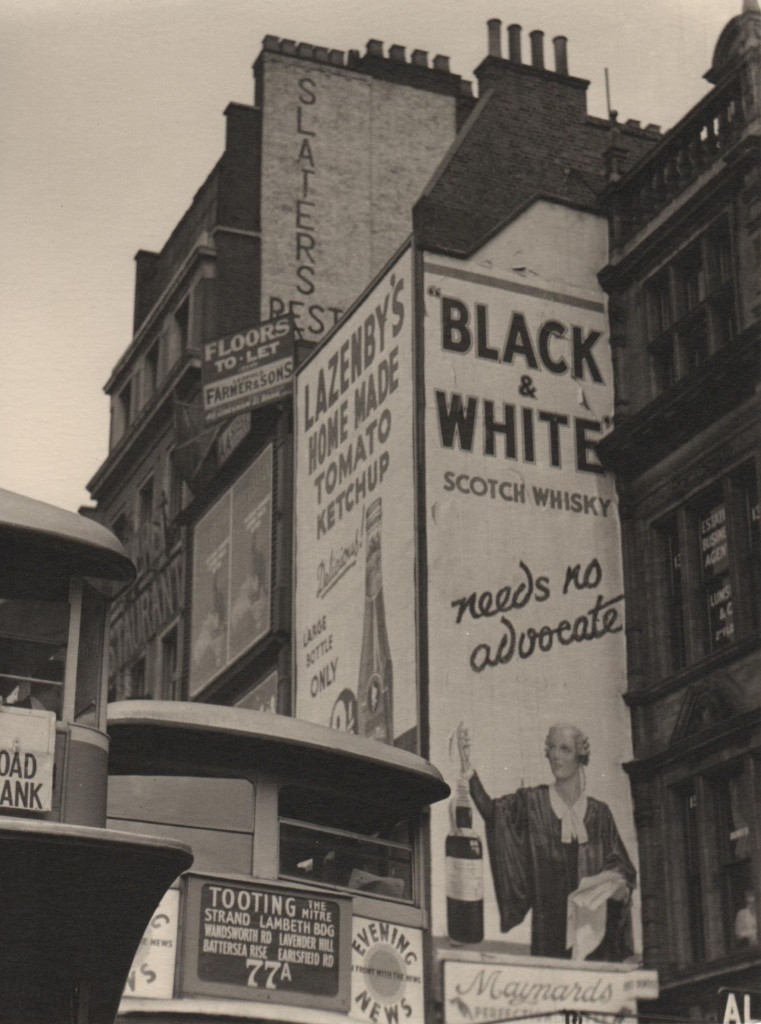 EXTENDED! Margaret Watkins’ Photographs of London in the 1930′s now on at the Gallery until March 30th! The show includes 60 of the renowned Scottish-Canadian photographer’s previously unseen images of London (many developed for the first time) plus several of her classics, including the famed Kitchen Sink.
EXTENDED! Margaret Watkins’ Photographs of London in the 1930′s now on at the Gallery until March 30th! The show includes 60 of the renowned Scottish-Canadian photographer’s previously unseen images of London (many developed for the first time) plus several of her classics, including the famed Kitchen Sink.
The celebrated Canadian photographer lived as a recluse in Glasgow for 40 years and her incredible photographs, many of which had been exhibited at the top galleries in New York, were only found after her death in 1969. The Gallery has previously shown the renowned Scottish-Canadian photographer’s images of Glasgow, Paris, Mosvow and Leningrad as well as her early photographs and her art and advertising work from New York in the 1920′s.
The Gallery is open 11-5, Tuesday-Saturday.
October 8th, 2015
West highland-based Dutch artist Inge Bos has her first exhibition in Britain of imaginative works on paper and board, in complete contrast to the traditional Scottish paintings of Tom Campbell (1865-1943)- woordland and other scenes in Milngavie and other Central Scotland locations. From Oct 10 to late Nov 2015.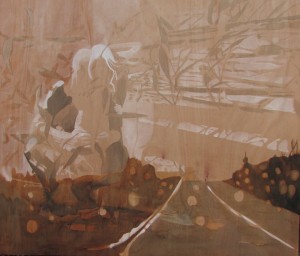
August 11th, 2015
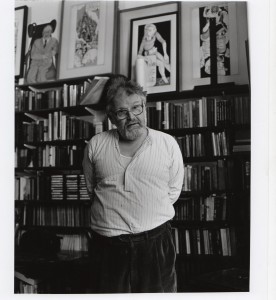
Alasdair’s family has asked us to let his many friends know that Alasdair continues to be critically ill after his accident in June. A serious spinal injury has left him largely incapacitated in the Intensive Care section of Glasgow’s Royal Infirmary, with a lung complication giving cause for concern. His son Andrew, home from the United States to be with Alasdair, has told us that small signs of improvement in recent days have given cause for some optimism. He’s not yet ready for visitors, who are limited for the present to his immediate family and one or two very close friends.
We plan to give a bulletin on Alasdair’s progress whenever there’s news.
The family thanks everyone for their concern, cards and letters.
(Photo credit: Alan Wylie)
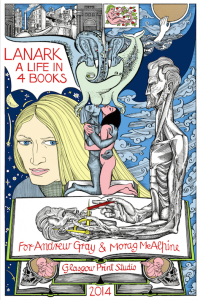
Lanark, A Life in Three Acts, the play based on Alasdair’s book Lanark, opens at the Citizen’s Theatre on the 14th of August and runs until the 19th of September. It will also be on from the 22nd to the 31st of August at the Royal Lyceum Theatre as part of the Edinburgh Festival.
The exhibition, Alasdair Gray: Sixty Years of Prints, will continue to be shown at the Hidden Lane Gallery until the end of August.
June 12th, 2015

Following on from the huge success of Alasdair Gray’s 2014 retrospective at Kelvingrove, this new exhibition covers his prints from his days at Glasgow School of Art in the 1950′s to the present day. Described by Anthony Burgess as ‘the most important Scottish writer since Sir Walter Scott’, Alasdair Gray’s visual creations from the past sixty years are featured, with a catalogue avaliable for sale.
April 11th, 2015
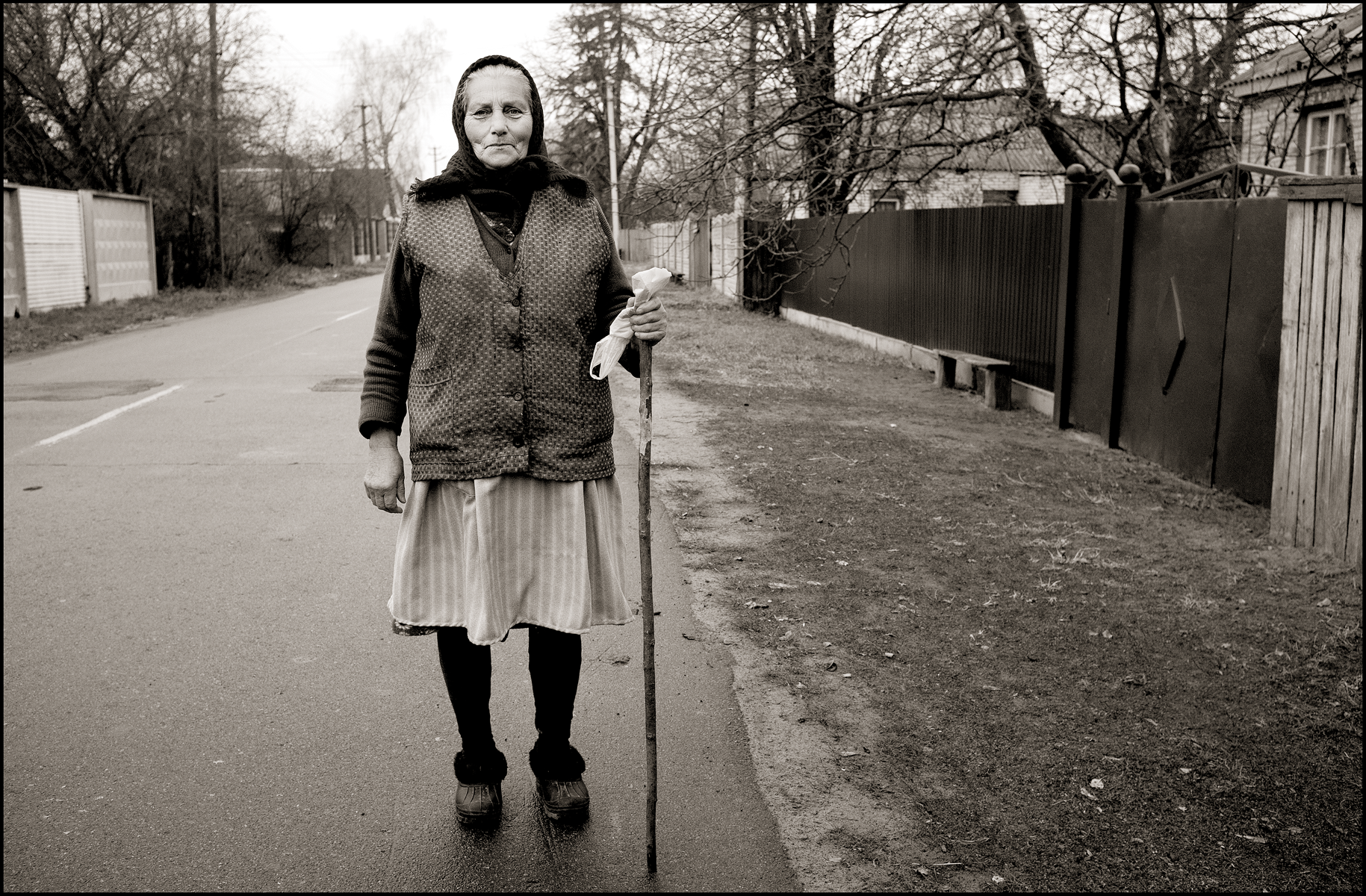


 On holiday in Crete in 2006, a chance meeting by Robert Burns with three Ukrainians kindled an interest that has brought the Glasgow photographer back to that ravaged country again and again. Best known for his portraits and coverage of jazz festivals, Robert is internationally recognised as a printmaker for his ability to get the best results, not only from his own creations, but also from the negative of other celebrated photographers. For ‘A Window On Ukraine’, Robert’s extraordinary work demonstrates his keen interest and empathy for the plight of the ordinary people in Kiev and other nearby towns and cities. He has recorded the joys and sorrows of Ukrainian life, the weddings, the festivals, children at play and vibrant street life. Robert’s work is currently benefitting charities there, particularly aiding children in Eastern Ukraine, where the horrors of Chernobyl still affect life decades after that horrendous disaster, with civil war now bringing further grief to the country.
On holiday in Crete in 2006, a chance meeting by Robert Burns with three Ukrainians kindled an interest that has brought the Glasgow photographer back to that ravaged country again and again. Best known for his portraits and coverage of jazz festivals, Robert is internationally recognised as a printmaker for his ability to get the best results, not only from his own creations, but also from the negative of other celebrated photographers. For ‘A Window On Ukraine’, Robert’s extraordinary work demonstrates his keen interest and empathy for the plight of the ordinary people in Kiev and other nearby towns and cities. He has recorded the joys and sorrows of Ukrainian life, the weddings, the festivals, children at play and vibrant street life. Robert’s work is currently benefitting charities there, particularly aiding children in Eastern Ukraine, where the horrors of Chernobyl still affect life decades after that horrendous disaster, with civil war now bringing further grief to the country.
December 11th, 2014
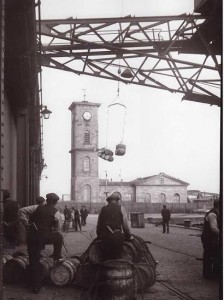
The renowned Canadian-born photographer Margaret Watkins lived in Glasgow unknown for more than forty years until her death in 1969. She left a legacy of more than twelve hundred superb images of exhibition standard, mainly of her work in the 1910′s and 1920′s in New York. A further treasure emerged after her death of thousands of negatives and occasional prints of her visits to Europe. More immediately, she took some seven hundred photographs of Glasgow in the 1930′s. This exhibition shows previously-unseen contact prints and enlargements which have been processed by master-printer Robert Burns, who has used the same chemical processes that Margaret Watkins would have utilised including selenium toning.
Only at the Hidden Lane Gallery; ends April 14th 2015
June 9th, 2011
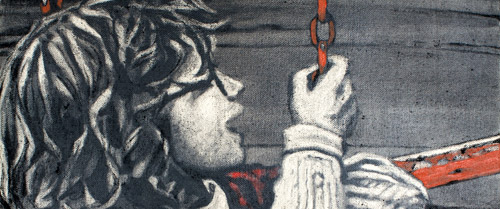
Lorcan Vallely was born in Armagh in 1979. His family have been involved in the art and music scene in Northern Ireland for two generations. He completed a foundation course in art and design at the Belfast Art College in 2000, before moving to Bath School of Art to study painting. After completion of his B.A. there, he attended a Postgraduate Diploma in Fine Art course at Chelsea College of Art in London in 2004, before spending a year in Oxford drawing and painting full time as a member of the artist-run Magdalen Road Studios.
He has exhibited in London, Bath, Oxford and throughout Ireland as well as in Italy. Since 2008 he has been working mainly from his studio in County Louth. He spent a year in Glasgow painting at a studio in the Hidden Lane.
Lorcan’s work has become instantly recognisable, with a very distinctive personal style.Using charcoal as his primary medium, and with a judicious use of acrylic, he layers his work to emphasise light and shade. This tonal quality gives his work an almost three-dimensional effect. The occasional use of oil to introduce colour brings an added vibrancy. He has had numerous solo and group exhibitions and has also completed many public and private commissions including “Song 4 Dylan” – a charcoal piece in response to a poem for the 7th Open House Festival in Belfast and “Mohammed al-Durra”, a large scale mural in Orgosolo, Sardinia.
This is his first exhibition in Scotland.
The exhibition will be running from 11th June until Mid August 2011.
Download the exhibition booklet
March 11th, 2011
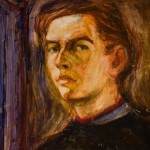 Ewen McAslan, a founder member of the Glasgow Group in the 1950’s, spent almost three decades as artist and teacher in Canada, returning to Scotland to live and paint in Pittenweem in 1994. His lifelong quest for “something else” found satisfaction in painting the Rockies and the prairies of Canada, and Scotland’s hills and valleys and rocky coasts – as well as haunting figurative works, many inspired by and depicting his wife Isobel.
Ewen McAslan, a founder member of the Glasgow Group in the 1950’s, spent almost three decades as artist and teacher in Canada, returning to Scotland to live and paint in Pittenweem in 1994. His lifelong quest for “something else” found satisfaction in painting the Rockies and the prairies of Canada, and Scotland’s hills and valleys and rocky coasts – as well as haunting figurative works, many inspired by and depicting his wife Isobel.
This is the first major exhibition in Scotland of Ewen’s work, on show at the initial behest of his peers from student days onwards, including Alasdair Gray, James Spence, Jack Knox, Ian McCulloch and Archie McIntosh.
Running from 17th March until 26th April 2011
September 6th, 2010
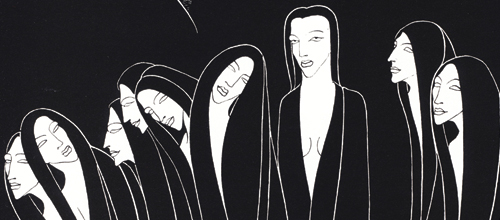
Hannah Frank, 1908 – 2008.
This new Hannah Frank exhibition opens at the gallery on 11th September and runs until the end of October.
Hannah Frank studied at Glasgow University and the Glasgow School of Art. She produced her hallmark black and white drawings, with their elongated structures, medieval romanticism and often melancholy air, from the age of 17 in 1925.
Between 1927 and 1932 the GUM, the Glasgow University Magazine, rarely came out without a drawing by ‘Al Aaraaf’, her chosen pen name. From the 1940s, after her marriage to mathematics teacher Lionel Levy, Hannah’s drawings became light-filled and exuberant.
Hannah turned to sculpture in 1952, studying with Benno Schotz, at the Glasgow School of Art. Hannah’s haunting drawings are resonant of the Art Nouveau period with a hint of Aubrey Beardsley and Jessie King. Hannah’s drawings, and her later sculptures, have been exhibited in the Royal Glasgow Institute, the Royal Academy, and the Royal Scottish Academy. In 2009 Hannah Frank became the first person ever to receive a posthumous honorary doctorate from Glasgow University, which was received on her behalf by her niece, Fiona Frank.
This exhibition is the first since Hannah Frank’s death, and includes the largest collection of Hannah Frank sculptures to be put on show for 20 years. It also includes five original Hannah Frank drawings that have resurfaced in a private collection in Norwich and were last seen by the public in the 1970s.
Also on show will be poems – and the Hannah Frank drawings that inspired them – written by winners and runners up to the first ever Hannah Frank Poetry Competition. The prize giving for this international competition took place at Kelvingrove Art Gallery and Museum, Glasgow on what would have been Hannah’s 102nd birthday – 23 August 2010.
Vanessa Austin Locke, who won the adult category of the competition, said: “I feel honoured to have had the opportunity to essentially collaborate with an artist whose work and legacy really touches me. Hannah’s work represents three themes that I feel very close to; the feminine, the fey and cultural Judaism. These were the strands that I tried to weave through my poem.”
We plan to run poetry workshops during the exhibition: watch this space or call the gallery for details. Schools and writing groups are also welcome to arrange to visit the gallery and run their own small sketching or poetry workshops: there is room for 16 people to sit in the lower level of the gallery. Call the gallery to book a time.
There will be an opportunity to bid on a small number of original Hannah Frank drawings as well as purchase signed prints and canvas reproductions of Hannah Frank art. Recasts of sculptures, books, prints – some signed – and cards, will also be on sale at the exhibition.
Hannah Frank, A Glasgow Artist.
Running from Saturday 11th September until end of October 2010.
Opening times: Tuesday to Saturday 11am – 5pm.
Entry is free.
For more information visit: http://www.hannahfrank.org.uk
July 20th, 2010
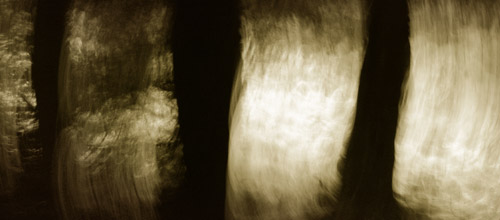
Douglas MacBride is a professional photographer. He lives in Killin , West Perthshire. His work involves commissions for advertisements and commercial work, for promotions of all sorts.
But, between assignments, Douglas has quietly developed a hitherto hidden talent for spotting the obscure, the unlikely, the mysterious and the beautiful in the hills and valleys and glens around his home.
To Douglas, a puddle can transform itself , with a bubble on its surface, into a strange and interesting observant eye. Or a tree, the match of its neighbours, can detach and become a fierce ( or comforting, depending on the viewer) bird winging its way toward the camera.
“For years I have worked taking photographs as my job. Much of the work was purely functional, featuring items in shots for publication. Much of it involved portraying people, particularly in the theatre and the arts,” he said.
“Then, a few years ago, I had a double bereavement. My mother and father died unexpectedly and within a very short time of each other. I found it difficult to cope, and would wander by myself in the hills above Killin. Gradually I would be aware of forms and patterns in the grasses, the trees, the ponds, and how they differed, but to an extent remained the same in summer, in rain, in ice and in snow.”
“I decided to try to record these, getting beneath, behind and beyond the actual objects I was photographing.”
Some are sinister and sad, but reflect Douglas’ view of the continuity of things past, present and in the future. He calls the collection of almost sixty images “Archaeology” to reflect delving into things in places where they have been in one form or another for weeks or months or years or decades. Fallen trees, an animal track on the ice, long discarded antlers or a sheep’s skull, the reflection in a puddle – all are transformed through his lens into timeless images which bring the viewer to deeper thoughts on what till then were the ordinary things never seeming worthy of a second glance.
Douglas studied photography at Napier College. He was born in Shettleston in the east end of Glasgow in 1956 in the same house where his father and his grandfather were born. The family farmed there for generations before the area was taken over and built on with council housing by the former Glasgow Corporation. He has had exhibitions of his theatre work at the Edinburgh Festival in 2004 and a major show of his imaginative images in France last year sponsored by the French Ministry of Culture. In 1993 one of his works was voted the Best Illustrative Still Life in the World by the Art Editors Guild in New York. Several silver and bronze awards followed from the same prestigious body. His advertising work has been shown in New York, London, Perth in Australian and in Singapore.
Archaeology: The photography of Douglas MacBride will be on show, 11 am – 5 pm, Monday to Saturday until 28th August.
February 26th, 2010
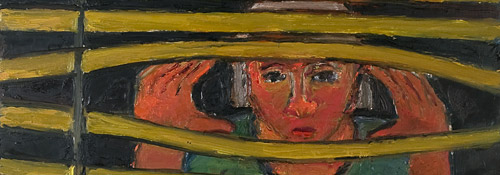
A fugitive from the Nazis, Hilda Goldwag arrived in Scotland in March 1939. Her family were due to follow from Vienna six months later – on the day war was declared, September 3rd. They all died in the Holocaust – probably in Dachau in 1943.
Hilda eked out a meagre living, first as a domestic servant in a minister’s home in West Linton, then in an engineering works in Glasgow, until the end of the war. She then joined Friedlanders in Hillington, designing headscarves for Marks and Spencer – and using the artistic talent first spotted at an early age in her native city, and developed at art school there.
That talent got a chance to expand through necessity when Friedlanders lost its scarf contract, and closed down. Freelance design included book illustrations ( among them Collins edition of Robert Louis Stevenson’s “A Child’s Garden of Verses”) and she returned to painting, mainly in oils.
Much of Hilda Goldwag’s work inevitably and properly reflects the sadnesses which remained with her until her death two years ago a few months short of her ninety sixth birthday. And much of it shows her determination to get as much as she could from a life that she knew to hold so many uncertainties.
For years she was a familiar sight around Cowcaddens and Garnethill, where she lived for many years and then, with her supermarket trolley piled up with her painting materials, on the banks of the canal, near to her abode in Knightswood to which she had moved when the Great Storm of 1967 took the roof off her city centre tenement flat.
She escaped the city sometimes to Torrance and Kirkintilloch – taking her paints and board on the bus – and laying the wet finished, or almost finished artwork on the luggage rack.
A rare chance to see her dramatic paintings of people, of her beloved canal, of sombre moonlight and sad harlequins – and gloriously happy nudes portraying mirth, of wild young boys running and jumping, of trees and flowers and mountains and fields comes at Glasgow’s Hidden Lane Gallery, in Argyle Street, Finnieston (following the successful Margaret Watkins’ photographic exhibition just ended which welcomed almost three thousand visitors.)
One riveting image perhaps sums up the watchful young woman who arrived in Glasgow seventy years ago, peering through the slats of a Venetian blind, apprehensive but wanting to see what is there, on the outside and recording it in her own totally distinctive way.
The exhibition, the second in the series of ”Forgotten Women” is open Tuesday to Saturday, 11 am to 5 pm from Monday 1st March 2010.
January 21st, 2010
* Please note that the Margaret Watkins Exhibition has now closed *
With over 2,500 people walking through the doors of the Hidden Lane Gallery to view the works of Margaret Watkins, by popular demand the exhibition will now be extended. Originally intended to end this weekend, the exhibition will now run until Saturday 6th February. Opening times will be as usual however if you require a private viewing, please contact us on exhibition@thehiddenlanegallery.com to discuss further.
December 22nd, 2009
Following on from Margaret Watkins will be the works of Hilda Goldwag, the Vienna-born painter who came to Glasgow in 1938 as a refugee from encroaching Nazism. Her family were to follow, but they all perished in one or other concentration camp.
Hilda Goldwag died in 2007 in Glasgow at the age of ninety six. Sporadic interest in her work brought her a small following, through exhibitions in Strathclyde University’s Collins Gallery , and at the Lillie in Bearsden. Mulholland hopes that the show at the Hidden Lane Gallery will bring her wider recognition, and help remove her from the category of (almost) forgotten women.
The Margaret Watkins theme will come and go at the Hidden Lane during the next couple of years. The first exhibition is general and wide ranging . There will be separate shows of her advertising work (which she regarded as equally important and equally artistic) of her visits to the then called Leningrad and to Moscow, her extensive work in Paris, and particularly in Glasgow in the 1930’s. The foreign tours and Glasgow pictures exist mainly in negative form, and will be shown as some original prints, backed up by many images printed in the original way by master printer Robert Burns.
Later in 2010 there will be exhibitions of glass, and of stained glass, and the first Scottish exhibition of the work of talented young Belfast painter Lorcan Vallely, who for some time had his studio in the Hidden Lane, to the rear of the gallery.
December 22nd, 2009

The opening exhibition is under the general theme of Forgotten Women, the first being the photographic work of Canadian-born Margaret Watkins, who was at the centre of artistic life in New York in the 1910’s and 20’s. She came in 1928 to Glasgow to visit her three maiden aunts – and got stuck, dying in 1969 in the Hyndland family home she inherited, alone and forgotten.
Prior to her death she gave a large box to Mulholland – on a strict promise that he would not open the tied and sealed trunk until after her death. Forty years after her demise, and with decades of work in the meantime, Margaret Watkins is at last receiving the recognition that eluded her after she left New York. The box contained original photographs taken, processed and printed by her. Many had been exhibited in major galleries in North America and Europe up to 1927. She is now in virtually every encyclopaedia of photography, and being recognised as the innovator of certain styles of photography credited to others, whom she taught. Among these were Paul Outerbridge (of the famed Ide Collar and later questionable nude studies) and Margaret Burke-White, who took the well known picture of Gandhi on his prayer mat, and the iconic images of the Chrysler building in New York in the 1930’s – as well as being one of the most celebrated of the Magnum war photographers.
































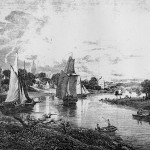

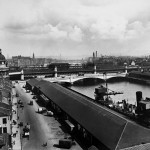




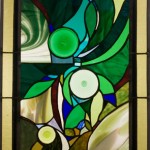
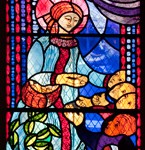















 Ewen McAslan, a founder member of the Glasgow Group in the 1950’s, spent almost three decades as artist and teacher in Canada, returning to Scotland to live and paint in Pittenweem in 1994. His lifelong quest for “something else” found satisfaction in painting the Rockies and the prairies of Canada, and Scotland’s hills and valleys and rocky coasts – as well as haunting figurative works, many inspired by and depicting his wife Isobel.
Ewen McAslan, a founder member of the Glasgow Group in the 1950’s, spent almost three decades as artist and teacher in Canada, returning to Scotland to live and paint in Pittenweem in 1994. His lifelong quest for “something else” found satisfaction in painting the Rockies and the prairies of Canada, and Scotland’s hills and valleys and rocky coasts – as well as haunting figurative works, many inspired by and depicting his wife Isobel.

